Suppose you have been hired as a financial consultant to Def
Suppose you have been hired as a financial consultant to Defense Electronics, Inc. (DEI), a large, publicly traded firm that is the market share leader in radar detection systems (RDSs). The company is looking at setting up a manufacturing plant overseas to produce a new line of RDSs. This will be a five-year project. The company bought some land three years ago for $4.5 million in anticipation of using it as a toxic dump site for waste chemicals, but it built a piping system to safely discard the chemicals instead. If the land were sold today, the net proceeds would be $5 million after taxes. In five years, the land will be worth $5.3 million after taxes. The company wants to build its new manufacturing plant on this land; the plant will cost $15 million to build. The following market data on DEI’s securities are current:
40,000 6.2 percent coupon bonds outstanding, 25 years to maturity, selling for 95 percent of par; the bonds have a $1,000 par value each and make semiannual payments.
DEI’s tax rate is 34 percent. The project requires $825,000 in initial net working capital investment to get operational.
Calculate the project’s Time 0 cash flow, taking into account all side effects. Assume that any NWC raised does not require floatation costs. (Do not round intermediate calculations. Negative amount should be indicated by a minus sign. Enter your answer in dollars, not millions of dollars (e.g., 1,234,567).)
The new RDS project is somewhat riskier than a typical project for DEI, primarily because the plant is being located overseas. Management has told you to use an adjustment factor of +2 percent to account for this increased riskiness. Calculate the appropriate discount rate to use when evaluating DEI’s project. (Do not round intermediate calculations. Enter your answer as a percentage rounded to 2 decimal places (e.g., 32.16).)
The manufacturing plant has an eight-year tax life, and DEI uses straightline depreciation. At the end of the project (i.e., the end of year 5), the plant can be scrapped for $2.1 million. What is the aftertax salvage value of this manufacturing plant? (Do not round intermediate calculations. Enter your answer in dollars, not millions of dollars (e.g., 1,234,567).)
The company will incur $3,500,000 in annual fixed costs. The plan is to manufacture 12,000 RDSs per year and sell them at $10,800 per machine; the variable production costs are $9,900 per RDS. What is the annual operating cash flow, OCF, from this project? (Do not round intermediate calculations. Enter your answer in dollars, not millions of dollars (e.g., 1,234,567).)
Calculate the net present value. (Do not round intermediate calculations. Round your answer to 2 decimal places (e.g., 32.16).)
Calculate the internal rate of return. (Do not round intermediate calculations. Enter your answer as a percentage rounded to 2 decimal places (e.g., 32.16).)
| Suppose you have been hired as a financial consultant to Defense Electronics, Inc. (DEI), a large, publicly traded firm that is the market share leader in radar detection systems (RDSs). The company is looking at setting up a manufacturing plant overseas to produce a new line of RDSs. This will be a five-year project. The company bought some land three years ago for $4.5 million in anticipation of using it as a toxic dump site for waste chemicals, but it built a piping system to safely discard the chemicals instead. If the land were sold today, the net proceeds would be $5 million after taxes. In five years, the land will be worth $5.3 million after taxes. The company wants to build its new manufacturing plant on this land; the plant will cost $15 million to build. The following market data on DEI’s securities are current: |
Solution
1-
cost of machine
15000000
investment in working capital
825000
initial cash outlay
15825000
2-
cost of debt
using rate function in ms excel
rate(nper,pmt,pv,fv,type)
3.31%
Annual after tax rate
(3.31*2)*(1-.34)
4.3692
cost of preferred stock
preferred dividend/market price
5.8/95
6.11%
cost of equity
risk free rate+(market risk premium )*beta
3.8+(7)*1.15
11.85
WACC on market value weights
source
value
weight
cost
weight*cost
debt
38000000
0.310711365
4.37
1.35780867
preferred
4275000
0.034955029
6.11
0.21357522
equity
80025000
0.654333606
11.85
7.75385323
122300000
WACC
sum of weight*cost
9.33
WACC for project
9.33+2
11.33%
3-
book value of machine after 5 years
15000000*(1-accumulated depreciation rate)
15000000*(1-.625)
5625000
scrap value of machine
2100000
loss on sale of machine
5625000-2100000
3525000
tax benefit on loss on sale of machinesale of
3525000*34%
1198500
after tax salvage value
2100000+1198500
3298500
year
0
1
2
3
4
5
initial investment
-15825000
sales
129600000
129600000
129600000
129600000
129600000
less variable cost
118800000
118800000
118800000
118800000
118800000
less fixed cost
3500000
3500000
3500000
3500000
3500000
less depreciation
1875000
1875000
1875000
1875000
1875000
operating profit
5425000
5425000
5425000
5425000
5425000
after tax profit = operating profit*(1- 34%)
3580500
3580500
3580500
3580500
3580500
net operatin after profit = after tax profit+ depreciation
5455500
5455500
5455500
5455500
5455500
recovery of working capital
825000
after tax scrap value
3298500
net operating cash flow
-15825000
5455500
5455500
5455500
5455500
9579000
present value of cash flow = net operating cash flow/(1+r)^n r= 11.33%
-15825000
4900296.416
4401595.631
3953647.38
3551286.61
5600916.9
NPV = sum of present value of cash flow
6582742.9
IRR = using irr function in MS excel =irr(-15825000,5455500,5455500,5455500,54555500,9579000)
25.56%
| 1- | cost of machine | 15000000 | |||||
| investment in working capital | 825000 | ||||||
| initial cash outlay | 15825000 | ||||||
| 2- | cost of debt | using rate function in ms excel | rate(nper,pmt,pv,fv,type) | 3.31% | |||
| Annual after tax rate | (3.31*2)*(1-.34) | 4.3692 | |||||
| cost of preferred stock | preferred dividend/market price | 5.8/95 | 6.11% | ||||
| cost of equity | risk free rate+(market risk premium )*beta | 3.8+(7)*1.15 | 11.85 | ||||
| WACC on market value weights | |||||||
| source | value | weight | cost | weight*cost | |||
| debt | 38000000 | 0.310711365 | 4.37 | 1.35780867 | |||
| preferred | 4275000 | 0.034955029 | 6.11 | 0.21357522 | |||
| equity | 80025000 | 0.654333606 | 11.85 | 7.75385323 | |||
| 122300000 | WACC | sum of weight*cost | 9.33 | ||||
| WACC for project | 9.33+2 | 11.33% | |||||
| 3- | book value of machine after 5 years | 15000000*(1-accumulated depreciation rate) | 15000000*(1-.625) | 5625000 | |||
| scrap value of machine | 2100000 | ||||||
| loss on sale of machine | 5625000-2100000 | 3525000 | |||||
| tax benefit on loss on sale of machinesale of | 3525000*34% | 1198500 | |||||
| after tax salvage value | 2100000+1198500 | 3298500 | |||||
| year | 0 | 1 | 2 | 3 | 4 | 5 | |
| initial investment | -15825000 | ||||||
| sales | 129600000 | 129600000 | 129600000 | 129600000 | 129600000 | ||
| less variable cost | 118800000 | 118800000 | 118800000 | 118800000 | 118800000 | ||
| less fixed cost | 3500000 | 3500000 | 3500000 | 3500000 | 3500000 | ||
| less depreciation | 1875000 | 1875000 | 1875000 | 1875000 | 1875000 | ||
| operating profit | 5425000 | 5425000 | 5425000 | 5425000 | 5425000 | ||
| after tax profit = operating profit*(1- 34%) | 3580500 | 3580500 | 3580500 | 3580500 | 3580500 | ||
| net operatin after profit = after tax profit+ depreciation | 5455500 | 5455500 | 5455500 | 5455500 | 5455500 | ||
| recovery of working capital | 825000 | ||||||
| after tax scrap value | 3298500 | ||||||
| net operating cash flow | -15825000 | 5455500 | 5455500 | 5455500 | 5455500 | 9579000 | |
| present value of cash flow = net operating cash flow/(1+r)^n r= 11.33% | -15825000 | 4900296.416 | 4401595.631 | 3953647.38 | 3551286.61 | 5600916.9 | |
| NPV = sum of present value of cash flow | 6582742.9 | ||||||
| IRR = using irr function in MS excel =irr(-15825000,5455500,5455500,5455500,54555500,9579000) | 25.56% |
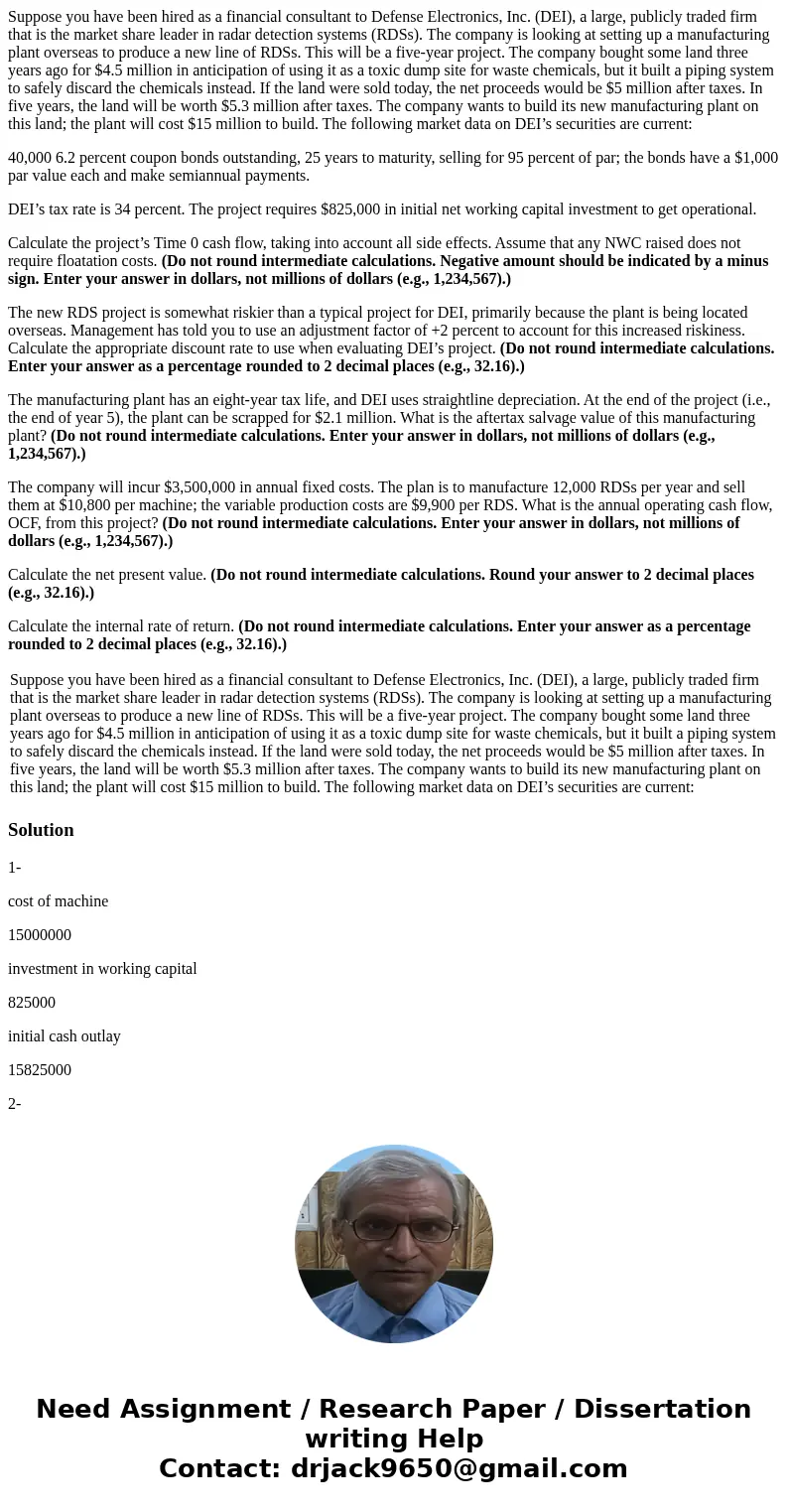
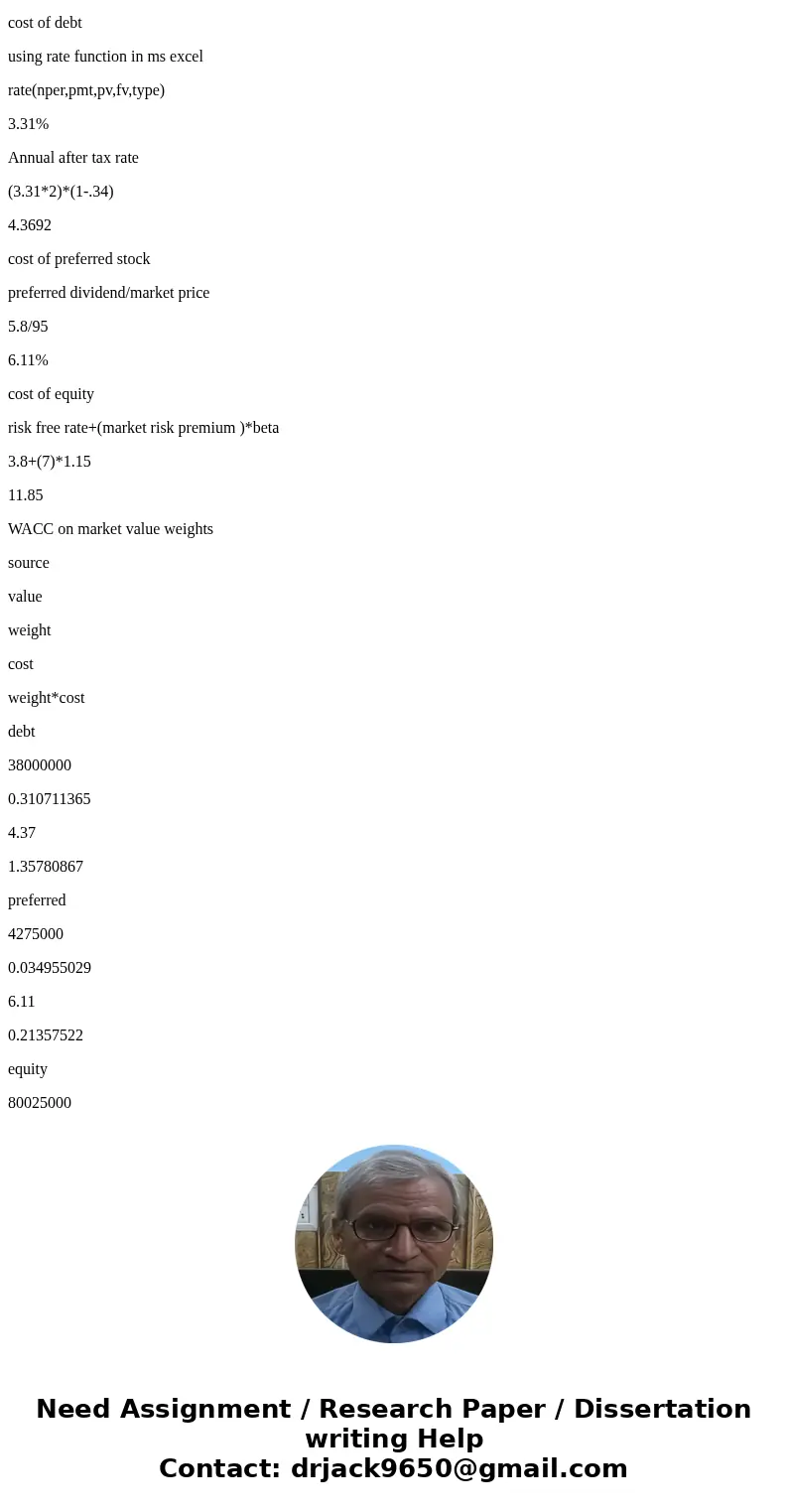
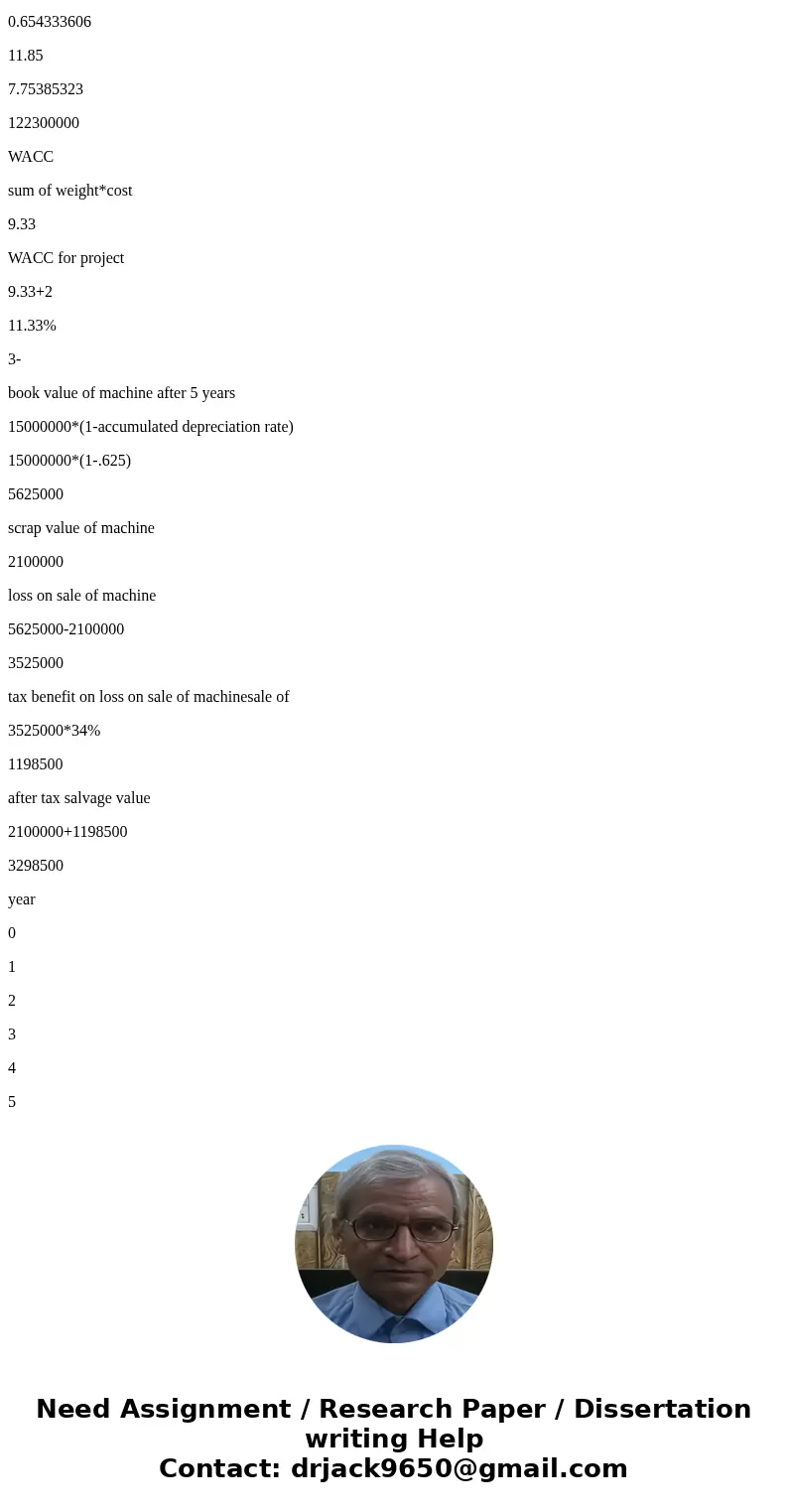
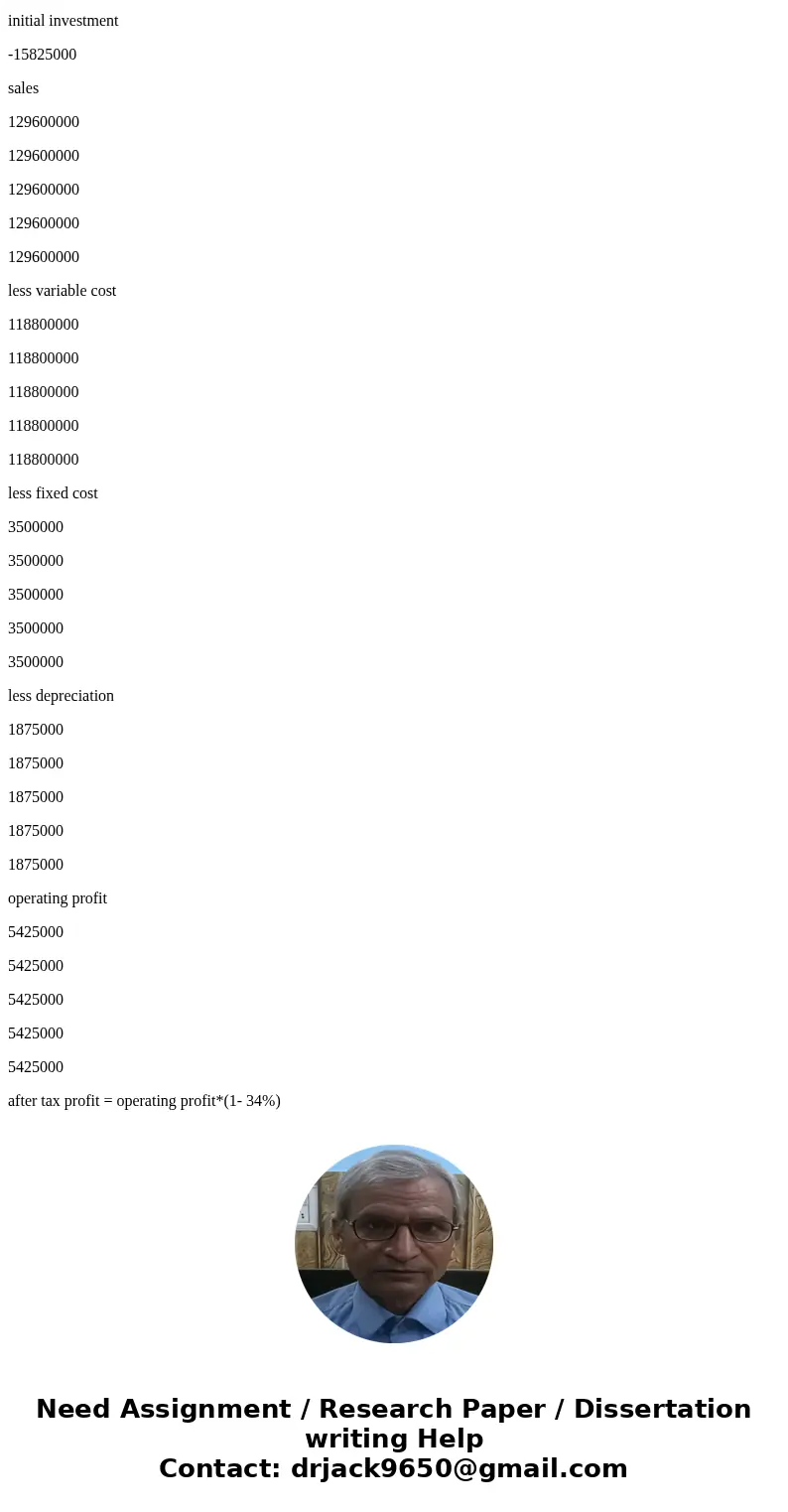
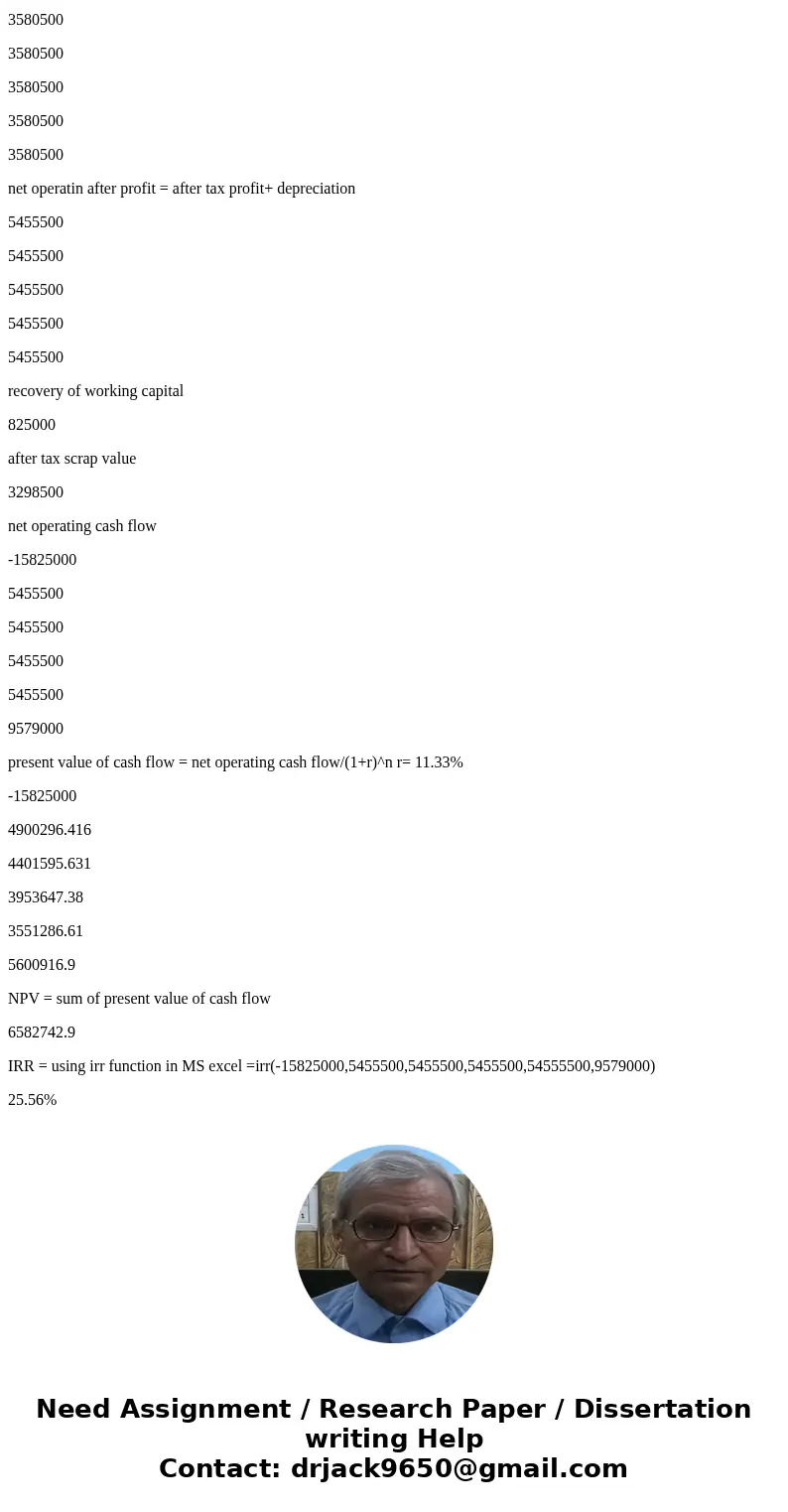
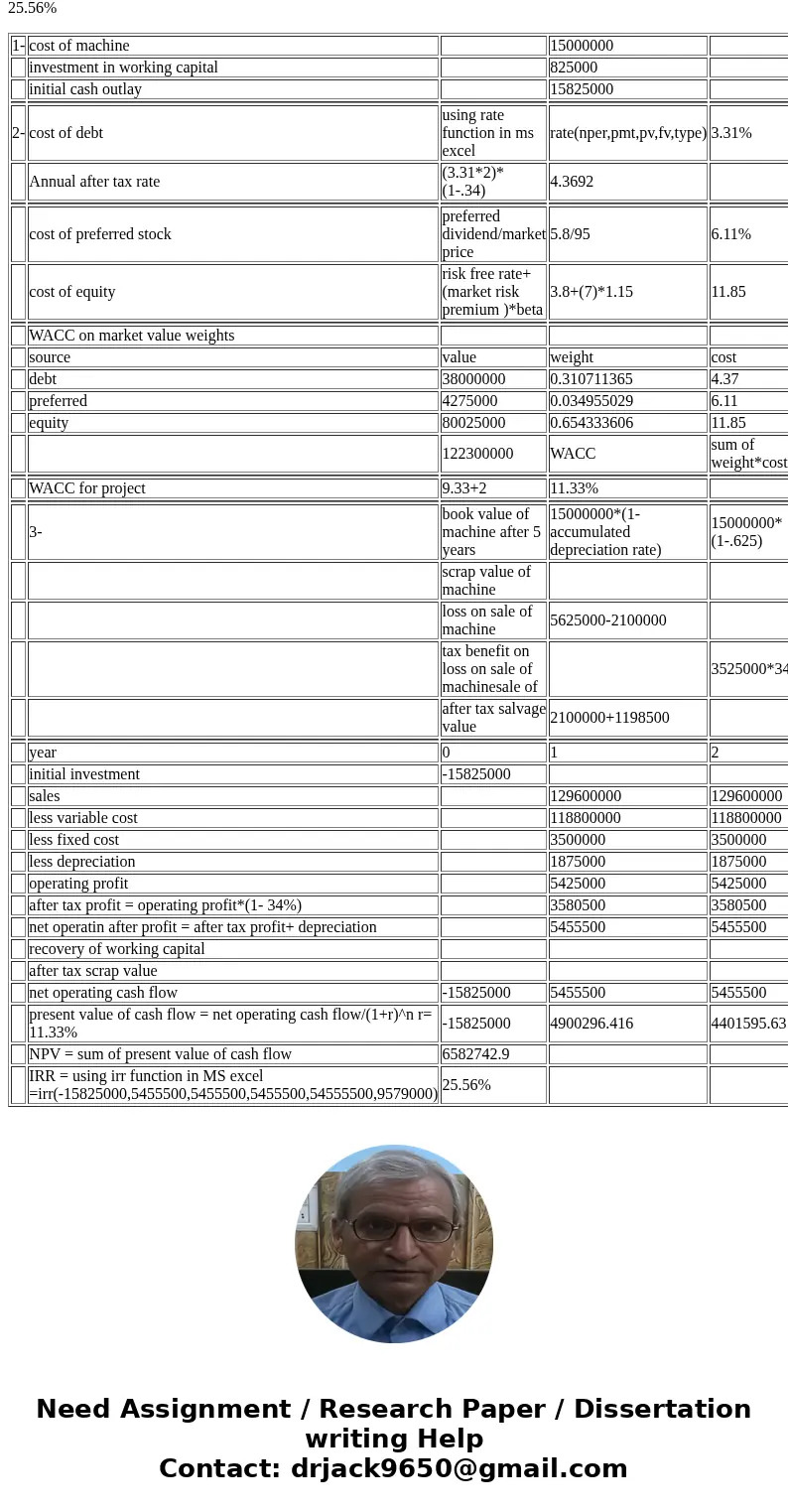
 Homework Sourse
Homework Sourse